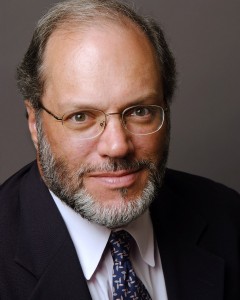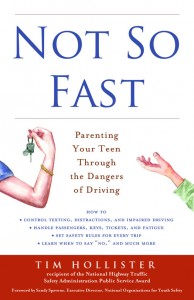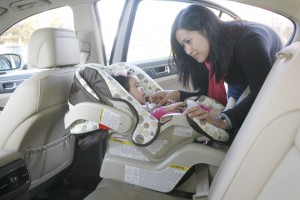06 – Parents – A Critical Component for Safer Teen Driving

November 23, 2013 | Posted in Podcast Episodes, Teen Driving | By Traffic Safety Guy
Comments Off on 06 – Parents – A Critical Component for Safer Teen Driving
Podcast: Play in new window | Download
Subscribe: RSS
A Conversation with Tim Hollister

Tim Hollister is a national expert on teen driving and author of the book Not So Fast: Parenting Your Teen Through the Dangers of Driving. As a parent whose 17 year-old son, Reid, died in a one-car crash while driving, Tim brings a unique perspective to the information parents must have in order to determine if their daughter or son should be driving. In Not So Fast, Tim presents a clear description of the risks teens face every time they get behind the wheel. He provides parents the benefit of his years of research and discusses specific recommendations aimed at decreasing the inherent dangers associated with teen driving.
In our conversation, Tim recounts his belief that prior to his son’s death he considered himself to be a well-informed parent about the risks his son faced while driving, and the steps he took afterwards to correct that mistaken belief. Tim’s book is designed to “help parents understand the real risks of teen driving” and assist them in determining if their teen should be driving on a particular day, or at all.
Teens and Safe Driving

Reid Hollister
In this episode Tim discusses a critical wrong assumption many parents make: that their teen is a good person and therefore a safe driver. In other words, the erroneous belief that it is the other driver who is the problem. As Tim points out, it is not possible for teens to have the necessary skills to be risk-free drivers due to a combination of biology, inexperience, and the essential time needed to hone one’s skills. Our brains and judgment are not fully developed until our mid-twenties. Add to this the fact that it takes three to five years of driving experience to become relatively safe drivers, and science and research tell us that no teen can be a completely safe driver.
This does not mean that parents cannot help their teens to be SAFER drivers. They can. It means that parents need to understand a teen’s limitations by being informed and then acting on that knowledge. During our discussion Tim provides critical considerations for parents and teen drivers, such as knowing the difference between purposeful driving and joyriding, and the importance of a Teen Driving Agreement (TDA). A model TDA is provided in his book.

Not So Fast
Created from his blog, From Reid’s Dad, Tim Hollister shares the best of his blog posts in twenty-six short chapters packed with priceless information,including:
- Why there is no Such Thing as a Safe Teen Driver
- What Driver’s Ed Isn’t
- The ABC of GDL (Graduated Driver Licensing)
- Negotiating and Enforcing a Teen Driving Agreement
- Managing Curfews, and
- Supervising the Brand-New Driver.
Tim helps parents understand the issues and how essential parental supervision is to the safety of their teens and everyone else on the road. Not So Fast is a must-read for any parent with a teen driver and this podcast episode is a great discussion of the author’s deeply personal experience and wealth of knowledge on the perils of teen driving.
RELATED LINKS:
Websites:
Resources:
Other:
- Traffic Safety Guy Blog – Teen Driving – I Know Everything
- Traffic Safety Guy Blog – Teen Driving – Speeding and Teenagers: Watch Out Parents–It’s a Deadly Combination
- Traffic Safety Guy Blog – Teen Driving: Parents, There Is More To Do
Video:
- Tim Hollister interviewed by Monika Samtani on the Extra Mile
- Teen Driver Safety: Reid’s Story
http://youtu.be/5KLii3Mhkps
05 – Child Safety Seats: Buckle Up—Every Ride, Every Time

November 1, 2013 | Posted in Child Safety Seats, Podcast Episodes | By Traffic Safety Guy
Comments Off on 05 – Child Safety Seats: Buckle Up—Every Ride, Every Time
Podcast: Play in new window | Download
Subscribe: RSS
A Conversation with Kate Carr
Ms. Kate Carr, CEO of Safe Kids Worldwide, talks about Child Safety Seats and their critical importance in saving children’s lives in car crashes. The easiest and most effective way to protect your child in a car crash is a child safety seat. This episode is a conversation on when, where and how to properly use a child car safety seat.

Use a rear-facing seat for children under 2 years old
The first step in protecting your child in a car crash is purchasing a car seat for your newborn, the second step is installing it correctly and the third step is actually buckling your child in it. With a 58% reduction in child deaths since 1987, it is clear that we have significantly improved our actions to protect children, but more needs to be done. One example discussed in this episode is Great Britain’s most famous newborn, Prince George. After being carried out from St. Mary’s Hospital in England, he was placed in a child safety seat located in the back seat, and it was a rear-facing—both fantastic actions. However, the straps in the car seat placed around Prince George were too loose, and he was wrapped in a lot of swaddling, concerns for child safety experts. Fortunately, the corrections are simple to make.
Child Safety Seat Inspections
Installing a child seat correctly is easily shown at any one of over 100,000 annual child car seat inspections. While at a car seat inspection, one of the 36,000 certified child car seat technicians will inspect the seat installation and provide advice and tips on making sure it is done correctly. The most important aspect of a car seat inspection is that parents are taught how to properly install the seat, an important lesson they take with them when they leave.
However, a new survey of parents with children under the age of 10 has raised significant concern: one in four parents admitted to not buckling a child in a car safety seat at least occasionally, citing such reasons as:
- It was “just” a short trip
- Time constraints due to feeling rushed
- Letting a child sleep laying down during overnight travel, and
- As a “reward.”
With a majority of crashes happening within 10 minutes of home, short trips and time constraints make it even more dangerous to fail to use a child car seat. A significant number of crashes happen in the evening hours, so allowing your child to lie down, while understandable, poses too much risk. And as both Kate and David note, a child buckled in a car seat is not punishment, it is safety, and the child’s life, and should never be negotiable. Ever. Clearly, the research demonstrates the importance of the Safe Kids Worldwide tag line: Buckle up, every ride, every time.
A Summary of the Key Points
Afterwards, David provides highlights of the conversation, noting that every parent of a young child should:
- Have a child safety seat and place it in the back seat
- For approximately a child’s first two years have a rear-facing car seat
- Check the label on the seat to make sure it is the right seat based on the age, height and weight of the child
- Check the car seat’s label for the expiration date
- Never use a car seat that has been in a crash
- At the right time, switch a child to a booster seat to ensure the adult seat belts fit properly and still protect the child, and
- When your child is old enough to “do it themselves” double-check to make sure they have—and when safe to do so, glance back now and then to make sure they have not unbuckled themselves.
From 1975 through 2011, an estimated 9,874 lives were saved by child restraints for children under the age of 5 in passenger vehicles—almost 10,000 lives saved because parents took the time to get child safety seats, and use them. Now, we must all make sure they are installed correctly and used ALL the time.


